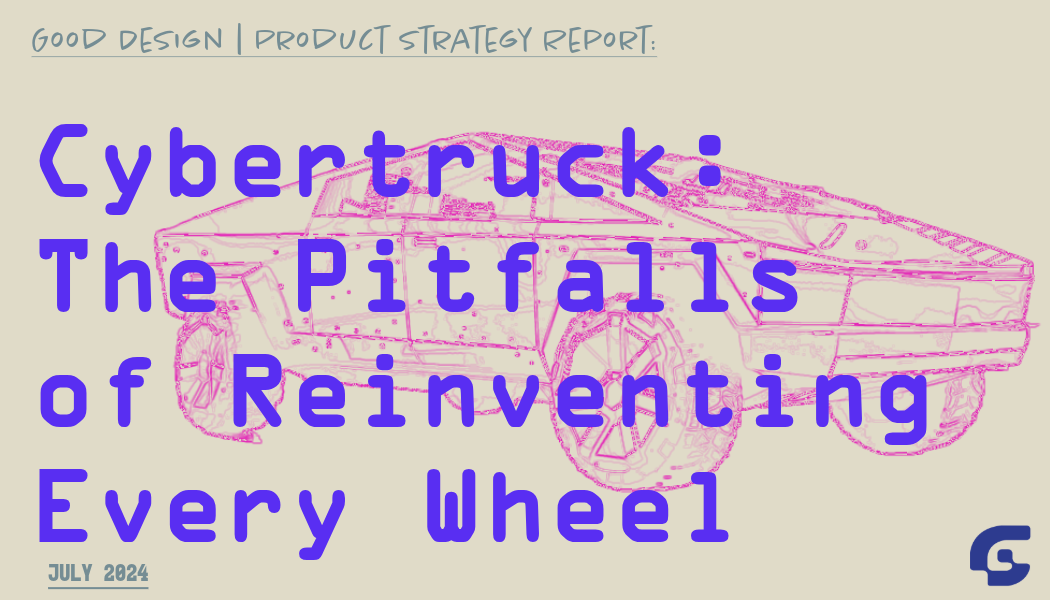Cybertruck: The Pitfalls of Reinventing Every Wheel
Tam Danier • 2024-07-17
In this article, the author explores the Tesla Cybertruck as a cautionary tale of prioritizing novelty over usability in design. They discuss the potential usability challenges and risks associated with the Cybertruck's unconventional features and highlight the importance of balancing innovation with user-centric design principles for long-term success.
A Cautionary Tale of Prioritizing Novelty Over Usability in Design
I. Introduction
Any company aiming to stay competitive seeks to redefine industries, reshape customer experiences, and gain a competitive advantage by introducing innovative products and services. This continuous pursuit of novelty is fueled by the promise of capturing consumers' attention, creating excitement, and establishing a unique brand identity in a highly competitive market. Tesla and its Cybertruck exemplify this zealousness.
However, this pursuit can sometimes lead organizations astray, as the desire to constantly reinvent the wheel may overshadow the basic principles of human-centered design and customer-centric product strategy. In their quest for innovation, companies may become so focused on reinvention that they overlook established user behaviors, mental models, and proven design principles. Understanding and respecting these user behaviors and mental models is crucial; it's the cornerstone of creating products that truly resonate with users.
Disruption and innovation are necessary for growth, but the trap is overengineering. When companies prioritize novelty over usability and disregard their target users' actual needs and concerns, they risk creating products that are more confusing than delightful and more frustrating than empowering. In their quest for groundbreaking features and cutting-edge aesthetics, organizations may unintentionally overlook the fundamental aspect of what makes a product genuinely successful – its ability to seamlessly integrate into the lives of its users, address their real needs, and deliver an exceptional user experience. They ultimately fail to maintain a balance between innovation and usability.
II. The Cybertruck: A Cautionary Tale of Over-Design
A. Unconventional Design and Features
Tesla's Cybertruck pushes the boundaries of innovation with its unconventional features, such as the ultra-hard 30X cold-rolled stainless steel exoskeleton, armored glass, and unique truck bed with a built-in ramp and lockable storage. However, the most striking departure from traditional design is the rearview mirror displayed on the 15-inch center console screen instead of a physical mirror.
B. Potential Usability Challenges and Risks of Over-Design
- Unfamiliar Design Language and User Experience: Cybertruck's unconventional design may create a steep learning curve for customers accustomed to traditional automotive designs, leading to confusion and safety hazards.
- Disruption of Established User Behaviors: Features like the center console rearview mirror and lack of door handles disrupt established user behaviors, increasing the risk of user errors and compromising the overall user experience.
- Steep Learning Curve for Ownership Experience: The cumulative effect of these unconventional design choices could result in a steep learning curve for owners, impacting the overall ownership experience and eroding brand loyalty.
- Over-Engineering and Added Complexity: Tesla's pursuit of innovation may have led to over-engineering certain aspects of the Cybertruck, adding unnecessary complexity that does not translate into tangible value for the customer.
A concrete example is the reverse camera's reported lack of depth lines. This makes it difficult for users to judge distances while parking or maneuvering, increasing the risk of collisions. This oversight highlights the consequences of prioritizing novelty over usability and overlooking users' fundamental needs.
The lesson: While innovation is essential for progress, over-designing and reinventing every aspect of a product without considering established user behaviors, mental models, and the principles of human-centered design can lead to suboptimal outcomes.
III. Analysis of the Cybertruck using the DVFU Framework
Analyzing the Cybertruck using GIO's DVFU framework, which includes desirability, viability, feasibility, and usability considerations, provides valuable insights into the opportunities and challenges associated with reinventing traditional automotive design.
Desirability
1. Unconventional Design and Features: The Cybertruck's unconventional design and features contribute to its desirability and emotional appeal. Its bold, futuristic aesthetic captures audiences. The sharp, angular lines and absence of curves set the Cybertruck apart from conventional trucks.
2. Emotional Appeal and Brand Identity: Cybertruck's avant-garde design leverages Tesla's strong brand identity and loyal following, especially among tech-savvy consumers and early adopters. The Cybertruck positions itself as a symbol of innovation and disruption in the automotive industry. Its futuristic aesthetics and cutting-edge features resonate with Tesla's brand image, appealing to those who value pushing boundaries and embracing the latest technological advancements.
Viability
While the Cybertruck's unique design and positioning as an all-electric, high-performance truck may appeal to a niche market of environmentally conscious and tech-savvy consumers, its ability to compete with established players in the truck market catering to more traditional buyer preferences remains to be seen. Understanding and addressing the needs of the broader truck-buying demographic will be essential for Cybertruck's widespread adoption.
Feasibility
1. Technical Capabilities and Manufacturing Challenges: Cybertruck's unconventional design and materials, such as the exoskeleton exterior and armored glass, may present significant technical and manufacturing challenges. Ensuring consistent quality, durability, and scalability is a formidable task that may impact the product's feasibility and time to market. Tesla's ability to overcome these challenges will attest to its engineering prowess and manufacturing capabilities. Lately, Tesla has issued three recalls for the Cybertruck–the accelerator pad, windshield wiper, and truckbed trim.
2. Supply Chain and Production Constraints: Tesla has faced well-documented challenges with production ramp-up and supply chain management. The Cybertruck's unique design and materials may exacerbate these issues, leading to production delays, quality control problems, and supply chain constraints. Addressing these challenges proactively and efficiently will be crucial for the successful launch and sustained production of the Cybertruck.
Usability
1. Unfamiliar Design Language and User Experience: Cybertruck's unconventional design presents significant usability challenges. The unfamiliar design language and user experience, such as the rearview mirror on the center console screen, could create a learning curve for customers accustomed to traditional truck designs and user interfaces. Ensuring a seamless and intuitive user experience will be essential to mitigate frustrations and foster widespread adoption.
2. Ownership Challenges and Customer Support: Cybertruck may face ownership and customer support issues like any groundbreaking product, especially in the early stages. Addressing these challenges promptly and effectively will be crucial to maintaining customer trust and loyalty. Tesla's ability to provide comprehensive support and address emerging issues will be vital in shaping the overall ownership experience.
By analyzing the Cybertruck using the DVFU framework, it becomes evident that while the product's unconventional design and features contribute to its desirability and emotional appeal, there are significant concerns regarding its viability, feasibility, and usability.
The Lesson: These concerns highlight the importance of balancing innovation and user-centric design, ensuring that the pursuit of novelty is consistent with the fundamental principles of creating seamless, intuitive, and customer-centric products.
IV. The Ownership Experience: A Crucial Consideration
A. Recalls and Quality Control Issues
The Cybertruck's unconventional design and manufacturing challenges have already raised concerns about quality control. Even before its official launch, reports of issues such as stress cracks in the windshield, misaligned body panels, and loose components have surfaced.
A concrete example of this is the reported issue of panels on the roof lifting after minimal use, raising concerns about the potential for other panels to become loose over time due to the vibrations and stresses of daily driving. These early indicators highlight quality control challenges and suggest that Tesla may face significant hurdles in ensuring consistent build quality, long-term durability, and reliability across its Cybertruck production.
B. Long Service Times and Limited Support
As a groundbreaking product, the Cybertruck may initially face limited service support and long wait times for repairs and maintenance. Tesla's service infrastructure and technician training will need to adapt to Cybertruck's unique requirements, leading to frustrations and delays for early adopters.
Owners have reported long wait times and inadequate repairs for issues like excess material on the driver's seat or stress cracks in the windshield, highlighting the need for prompt and effective service support. Tesla needs to address these service challenges promptly to avoid customer dissatisfaction and erosion of trust in the brand.
C. Warranty Limitations and Disclaimers
Tesla's approach to the Cybertruck's warranty and disclaimers has already raised eyebrows among customers. The company's owner's manual includes several caveats and limitations, such as specific instructions for cleaning and maintaining the stainless steel body, which could be an additional burden on owners.
For example, the manual advises against washing the Cybertruck in direct sunlight, using certain car shampoos, or even using hot water, as these can damage or discolor the stainless steel exterior. These stringent requirements for proper maintenance present an additional inconvenience for owners, impacting the overall ownership experience.
D. Erosion of Customer Trust and Loyalty
If Cybertruck's ownership experience is marred by recurring quality issues, limited support, and restrictive warranties, it could significantly erode customer trust and loyalty. Tesla's brand reputation, built on innovation and cutting-edge technology, could be tarnished if the Cybertruck fails to deliver a seamless and hassle-free ownership experience.
Maintaining customer confidence and promptly addressing emerging issues will be crucial for Cybertruck's long-term success.
The Lesson: Failure to maintain customer trust and loyalty may make customers feel that the novelty factor alone is insufficient to justify their investment, leading to dissatisfaction and defection to competitors.
V. The Dangers of Prioritizing Novelty Over Usability
A. Erosion of Customer Experience
The Cybertruck's unconventional design and features may initially captivate customers, but the novelty could quickly wear off if it sacrifices usability. Unfamiliar interactions, such as the rearview mirror on the center console screen, could lead to cognitive overload and frustration for users accustomed to traditional automotive design cues, ultimately undermining the appeal of Cybertruck's innovative features.
Prioritizing novelty over usability can also have severe implications for user safety. The Cybertruck's sharp angles, unconventional controls, and unfamiliar design language could increase the risk of user errors, leading to accidents or safety hazards.
B. Overlooking the Complete Customer Journey
Companies like Tesla should focus on the entire customer journey when introducing a groundbreaking and attention-grabbing product. Although Cybertruck's unusual design and marketing raised awareness and interest during the pre-purchase phase, the real challenge is providing a smooth and satisfying ownership experience.
The initial excitement and novelty surrounding the Cybertruck's bold design and features may eventually wear off, leaving customers dissatisfied if the ownership experience fails to meet their expectations. Suppose the Cybertruck's usability challenges, quality issues, or limited support overshadow its innovative aspects. In that case, customers may feel that more than the novelty factor is needed to justify their investment, leading to dissatisfaction and defection to competitors.
The lesson: Innovation should never come at the cost of compromising user safety or creating unnecessarily complex interactions.
VI. Lessons for Product Strategists
A. Balancing Innovation with Usability
Innovation is crucial for progress and gaining a competitive edge. Still, the Tesla Cybertruck case is a cautionary tale about the dangers of overengineering and reinventing every aspect of a product. Not everything needs reinventing, especially if it sacrifices usability and established user behaviors.
As product strategists, it's crucial to balance introducing new features with leveraging existing mental models and behaviors that users are already familiar with. By building upon established design principles and user interactions, companies can reduce customers' cognitive load, minimize the risk of user errors, and facilitate the adoption of new products.
Gather customer feedback and refine product design and user experience to achieve this balance. Rapid prototyping, user testing, and incorporating insights from diverse user groups can help identify usability issues early on, allowing for adjustments and ensuring that innovation meets user needs and preferences.
For instance, if Tesla had actively sought and incorporated customer feedback during Cybertruck's development process, they might have identified usability challenges associated with the rearview mirror on the center console screen. By iterating on the design and testing alternative solutions with users, Tesla could have refined the feature to better align with established user behaviors and mental models, reducing the risk of cognitive overload and user frustration.
B. Considering the Entire Customer Journey
The challenges with the Cybertruck underscore the importance of considering the entire customer journey, from initial awareness and purchase to long-term ownership and support. While Tesla's marketing efforts have generated buzz around the Cybertruck's unconventional design, the company has overlooked the crucial aspects of the ownership experience.
Product strategists must prioritize seamless experiences throughout the customer journey, ensuring that the novelty and excitement of the initial purchase are sustained through exceptional post-sales support, prompt issue resolution, and continuous iteration based on user feedback. Neglecting the ownership experience can lead to customer dissatisfaction, eroding trust and loyalty, even for the most innovative products.
C. Addressing Real Customer Needs and Pain Points
Innovation should be driven by a deep understanding of customer needs and pain points rather than being pursued solely for its novelty. While the Cybertruck's unconventional features may grab attention, they may not always meet traditional truck buyers' core needs and expectations, such as practicality, utility, and ease of use.
Product strategists must ensure that their innovations offer tangible value beyond novelty, address customer problems, and provide sustainable competitive advantages. By aligning product development with customer needs, companies can create products that resonate with their target audiences and deliver lasting value.
For example, the reported lack of a 360-degree overhead camera system in the Cybertruck reflects a missed opportunity. This feature, increasingly common in similar vehicles, can significantly enhance usability and practicality, addressing a real need for improved visibility and ease of maneuvering. By overlooking this feature, Tesla may limit Cybertruck’s' appeal and adoption among traditional truck buyers.
D. The Value Proposition Beyond Novelty
While the Cybertruck's bold design and cutting-edge features have captured many imaginations, its success ultimately depends on delivering a compelling value beyond novelty. As the initial excitement fades, customers expect a seamless ownership experience, reliable performance, and practical utility that justifies their investment.
Product strategists should focus on creating enduring value by addressing real customer needs, providing sustainable competitive advantages, and continuously iterating based on user feedback. Novelty alone is not a sustainable strategy; it must be accompanied by a deep understanding of customer pain points and a commitment to delivering exceptional experiences throughout the product's lifecycle.
E. Aligning Stakeholder Interests
A successful product strategy requires aligning the interests of various stakeholders, including customers, employees, partners, and investors. The Cybertruck exemplifies a disconnect between Tesla's pursuit of innovation and the practical needs of truck buyers, as well as customer expectations regarding quality control and post-sales support.
Product strategists must foster an environment that encourages open communication and collaboration among stakeholders, identifying and addressing their unique needs and concerns. By fostering mutually beneficial solutions, companies can create products that captivate customers and resonate with employees, partners, and investors, ensuring long-term success and sustainability.
For example, unwanted attention from onlookers and enthusiasts has been reported, which could disrupt the everyday use and privacy of cybertruck owners. By aligning customers' interests, who value privacy and convenience, with those of employees (e.g., service and sales personnel), Tesla could develop solutions that enhance the overall ownership experience while maintaining the product's appeal and uniqueness.
Tesla could explore strategies for managing and mitigating unwanted attention, such as providing dedicated service lanes or private delivery options for Cybertruck owners. This would allow customers to have their vehicles serviced or delivered without drawing unnecessary attention while streamlining the process for service personnel and dealerships.
Additionally, Tesla could implement measures to protect the privacy of Cybertruck owners, such as offering tinted windows or privacy screens as optional features. This would cater to customers who value discretion while allowing enthusiasts to appreciate the vehicle's unique design from a respectful distance.
Furthermore, Tesla could leverage its existing network of partners and influencers to educate the public about responsible and respectful behavior towards Cybertruck owners. By fostering a culture of understanding and respect, Tesla could mitigate the disruptions caused by excessive attention while capitalizing on the vehicle's novelty and appeal.
By actively engaging with stakeholders, understanding their diverse needs, and fostering open communication, Tesla could develop innovative solutions that align the interests of customers, employees, partners, and investors, ensuring a successful and sustainable product strategy for Cybertruck.
The lesson: By prioritizing seamless usability, addressing real customer needs, and considering the entire customer journey, product strategists can ensure that innovation and novelty are not pursued at the expense of delivering a truly exceptional and enduring product experience.
VII. Conclusion
A. The Cybertruck as a Cautionary Tale
The Tesla Cybertruck is a cautionary tale about the downsides of prioritizing novelty over usability, overlooking the complete customer journey, and failing to address real customer needs and pain points. While the product's unconventional design and features have attracted significant attention, the reported issues surrounding quality control, ownership experience, and practical utility raise critical questions about the long-term viability of such an approach.
B. Prioritizing Customer-Centric Design for Long-term Success
As product strategists navigate the constantly evolving innovation landscape, prioritizing customer-centric design principles and holistic product strategy frameworks is paramount. Balance innovation with usability, considering the entire customer journey; address real customer needs; align stakeholder interests to create products that captivate audiences, deliver lasting value, and foster long-term customer loyalty.
C. The Importance of Holistic Product Strategy Frameworks
The challenges faced by Cybertruck underscore the importance of adopting holistic product strategy frameworks, such as GIO's DVFU model, which integrates desirability, viability, feasibility, and usability considerations. Using such frameworks, product strategists can make informed decisions, mitigate risks, and optimize their products for long-term success in an increasingly competitive and customer-centric market.
Ultimately, the journey of the Cybertruck serves as a reminder that true innovation lies not in reinventing every wheel but in creating products that seamlessly integrate into customers' lives, address their real needs, and deliver exceptional experiences throughout the product's lifecycle. Product strategists can drive sustainable growth and success in the ever-evolving business landscape by embracing a customer-centric approach, leveraging iterative design processes, and aligning stakeholder interests.
Tam Danier is the managing director at Good Ideas Only, a strategy and design agency.




